Heat Gas Boiler
Space Heating Equipment
Overview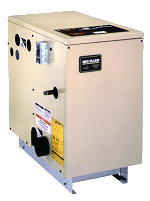
Around 75 years ago the steam boiler was considered the premium heating system and only the highest cost homes had them. About 50 years ago it was the hot water or hydronic boiler that was the premium system. About 10 years ago the boiler had all but disappeared from the residential sector. Today, they are still considered the premium system and a new design of compact, high efficiency boilers are seeing a market resurgence.
Boilers are much more expensive to purchase and install than forced air systems. They have no ductwork or fan, so central space cooling is more expensive to install also. Until recently, boilers were not as efficient as forced air furnaces. All of these factors worked against the boiler’s market penetration.
With under floor radiant heating and snow melting systems residential boilers have enjoyed a small niche ‘comeback’. Also for older homes that have always had a boiler system, a new high-efficiency replacement boiler can be a good investment.
Boiler systems are either low pressure steam or hot water.
Boiler systems are easier to zone and control than forced air systems. “Boiler people” agree that boiler systems provide a more comfortable heating atmosphere than forced air systems, and they are much quieter. Boilers tend to be the most popular in the coldest areas of the country because of their ability to provide steady/even and intense heating under extreme outdoor temperature conditions.
However, boilers are not more efficient than forced air furnaces just because they may be “more comfortable”. A 90% efficient boiler has the same efficiency as a 90% forced air furnace – that is, at producing heating BTUs from the fuel at the source. There are other variations that can impact the overall efficiency of the systems – such as a leaky duct work system running through an attic will significantly reduce the system efficiency. When boiler pipes leak, it gets noticed and fixed right away; but when duct work leaks, people tend to think that’s “normal”.
Residential boilers are normally rated in BTUs per hour input capacity. Commercial and industrial boilers are rated in Horse Power. One Boiler Horse Power equals about 42,000 BTUs of INPUT energy.
Operation
Traditionally boilers were large and made with heavy components. Many boilers today are still made with cast iron heat exchangers, but their sizes have been reduced as material and casting technologies have improved. Boilers are also made with copper tubes or fins, stainless steel, and a variety of other exotic materials that are light-weight, thermal shock and corrosion resistant.
Hot water boilers have an aquastat that controls the burner. The aquastat senses the water temperature and turns the burner on and off to maintain the water set-point. The house thermostat controls the circulation pump that delivers the hot water to the radiators. In a multi-zone system, there are either multiple circulation pumps or valves that are controlled by multiple thermostats.
Older boilers did not have vent dampers, so that was a common energy efficiency measure in the 1980’s. If a boiler is still in good operating condition and it does not have a vent damper, one should be installed. If the boiler is near the end of its ‘life’, don’t bother. When a new boiler is purchased it will come with a vent damper as one is generally required to meet Federal efficiency requirements of new equipment sold in the US and Canada. Or, it may have an advanced combustion system and not require a vent damper. Typical payback on a vent damper retrofit is 3 – 5 years.
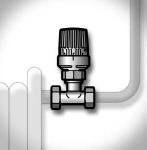 Steam boilers are controlled by steam pressure. A pressure gauge turns the burner on and off to maintain a set pressure. Room thermostats open and close valves (shown in graphic to the right) on the steam radiators to regulate space temperature. The more the valves to the radiators are open, the more the burner must fire to maintain steam pressure. Steam forms condensate (water) as its heat is removed. The condensate returns to the boiler where it is reheated into steam. A Steam Trap is used to keep steam in the radiator and allow condensate to drain out and return to the boiler. Steam valves are located on the top/entrance to the radiator, and steam traps are located on the bottom/exit of the radiator (in 2 pipe systems).
Steam boilers are controlled by steam pressure. A pressure gauge turns the burner on and off to maintain a set pressure. Room thermostats open and close valves (shown in graphic to the right) on the steam radiators to regulate space temperature. The more the valves to the radiators are open, the more the burner must fire to maintain steam pressure. Steam forms condensate (water) as its heat is removed. The condensate returns to the boiler where it is reheated into steam. A Steam Trap is used to keep steam in the radiator and allow condensate to drain out and return to the boiler. Steam valves are located on the top/entrance to the radiator, and steam traps are located on the bottom/exit of the radiator (in 2 pipe systems).
Distribution Systems
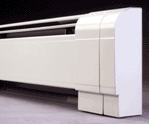 Hot Water
Hot Water
Water systems use pumps to circulate the water to copper or aluminum finned baseboard heaters. The water temperature determines the capacity and how fast the heat comes from the baseboard heaters. In properly designed systems, water temperature should be between 140 and 180F. Commercial boilers and some newer residential units, have a control that varies the water temperature (called a Boiler Reset) with the outdoor temperature. The lower the water temperature, the more efficient the boiler and the more gentle the heating. The water temperature can be manually adjusted throughout the heating season, but this is not normally recommended to the average home owner. It would however improve efficiency.
Depending on the design of the system, it may have one pipe that runs around the entire house perimeter, or it may have multiple zones that form loops from the boiler to different parts of the house. Baseboard radiators have air control louvers to minimize the amount of heat that can come out for a little added temperature control.
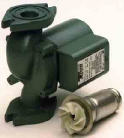 Multiple zone systems have separate piping and a thermostat for each zone. Each zone may share a pump or use multiple pumps. Zone temperature is controlled by turning the pump on and off, or opening and closing a thermostatic valve if a shared pump is used. The boiler water temperature maintains a constant setting according to the aquastat. The more heat used by a zone, the colder the water when it returns to the boiler. This is one reason why rooms at the end of the loop could be colder than rooms at the start of the loop. A well designed system will have a little more radiator for rooms at the end of the loop to compensate for lower water temperature.
Multiple zone systems have separate piping and a thermostat for each zone. Each zone may share a pump or use multiple pumps. Zone temperature is controlled by turning the pump on and off, or opening and closing a thermostatic valve if a shared pump is used. The boiler water temperature maintains a constant setting according to the aquastat. The more heat used by a zone, the colder the water when it returns to the boiler. This is one reason why rooms at the end of the loop could be colder than rooms at the start of the loop. A well designed system will have a little more radiator for rooms at the end of the loop to compensate for lower water temperature.
For more information on distribution systems see Radiant Hydronic Heat
Steam Systems
There have been a variety of steam distribution systems used over the past 150 years; they are mainly described by the number of separate parallel pipes in the system. Residential systems use either 1- or 2-Pipe systems. Commercial systems may have up to 4-Pipes.
In a 1-Pipe system, steam and condensate travel to and from radiators in the same pipe. The pipe is installed on an angle to slope back to the boiler. Steam flows by pressure up the top inside of the pipe and condensate (water) flows by gravity on the bottom inside of the pipe. These are very old systems using cast iron pipe at least 2″ in diameter.
In a 2-Pipe system, steam flows in one pipe and condensate in the other. The steam flows by pressure and the condensate may be by gravity or pump.
Radiator temperature is controlled by a thermostatic valve (or a manual valve in very old systems) that allows steam into the radiator; a steam trap keeps the steam in the radiator and only lets condensate out (see above).
Conversion of Steam to Water
Some systems have been successfully converted from steam to hot water. This may be for a historic house that wanted to keep the original steam radiators, but did not want to maintain a steam boiler and controls. However, it does not always work. The water temperature is much lower than the steam temperature so a radiator will not put out as much heating capacity, and the distribution pipes should be changed to smaller diameter piping – at least where accessible. The old radiators and pipe must also be chemically cleaned on the inside, as years of scale build-up could render the system useless when using hot water.
Pipe Insulation
All water pipes that run through unconditioned spaces should be insulated. Insulate the water pipes in conditioned spaces to better control heat output (so that the heat comes from the radiators only). All steam pipes should be insulated regardless of where they run because of their high temperature. Condensate return lines should also be insulated, as the water temperature is still quite high and will save BTUs at the boiler. See Duct Insulation
Radiator Reflectors
Radiators emit energy in all directions. Many radiator units are built with self-contained reflectors or air dampers designed to direct energy towards the heated space. However, a substantial amount of energy still transmits though the rear of the radiator and into the exterior wall. Adding a radiant barrier/reflector between the radiator and the wall can reduce this loss. See Radiator Reflectors
Efficiency
Boiler efficiency is heavily influenced by how well it has been maintained. Water that has not been properly treated leads to scale build-up inside the heat exchanger and radiators, and soot or rust build-up on the outside of heat exchangers, dramatically reduce boiler efficiency.
Some general AFUE guidelines are:
Older boilers with questionable maintenance – 50 – 60% at best
Boilers 10 – 30 years old with adequate maintenance 60 – 70%
New Standard Efficiency Boilers 80 – 85% (non-condensing – ie: they have a metal flue pipe)
New High Efficiency Boilers 85 – 95% (Condensing -plastic flue pipe)
AFUE = Annual Fuel Utilization Efficiency
More Information
Manufacturers
Notice: There are many brand names of residential boilers; this listing in no way is intended to be all inclusive or endorsing. It is only provided as a convenience to find several major brands that are available in most of the US and Canada.


The Independence PV steam boiler offers the same dependability as the Independence with the addition of a draft inducing fan. This allows the Independence to be installed in jobs where a chimney is not present or up to code by venting directly through an outside wall. Burnham’s Independence PV is ideal for older, more urban retrofits like city buildings.
Go to the Burnham web site at www.burnham.com

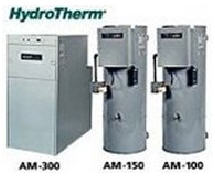
- High efficiency condensing gas boiler
- Highest A.F.U.E. rating in the industry (90.6%)
- Patented, sealed combustion principle
- Direct vented, pulse combustion
- Stainless steel heat exchanger
- Low NOx
- Ideal for radiant floor systems
Go to the HydroTherm web site at www.hydrotherm.com


- 85+% AFUE
- Automatic burner modulation from 57% to full fire
- NOx levels less than 25 ppm
- Venting – Direct vent (sealed combustion with ducted combustion air in concentric vent) or Category III
- Built-in diagnostics with memory and 3-character alpha-numeric temperature readout and error codes
Go to the Laars web site at www.laars.com


The Peerless® Pinnacle® gas-fired boiler is available for either natural or LP gas and is offered in six sizes, including three new models. High-grade stainless steel construction assures the boiler’s durability. The new metal mesh burner elements improve turndown and reduce emissions. The compact, lightweight design of the boiler allows for maximum installation flexibility. Features such as a fully modulating burner, spark ignition, safety relief valve, and the Gas Valve – Venturi System ensure safe, efficient operation. Two new Pinnacle models are available as wall-mounted units. A third new model – the PI-399 – offers 95% combustion efficiency in a commercial-size boiler (please reference the Pinnacle PI-399 on our website for additional information). The Pinnacle boiler is as quiet as most home appliances. As with all Peerless products, a comprehensive warranty and the dependable Peerless name back the Pinnacle boiler.
Go to the Peerless web site at www.peerlessboilers.com

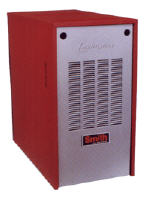
Lexington Series gas-fired, direct-vent/sealed combustion boilers combine outstanding performance and efficiency in an easy-to-install and service design. Lexington Series direct vent boilers use 100% outside air for combustion to reduce heating costs and provide safe, dependable operation. We call it the Lexington …you’ll call it revolutionary.
Go to the Smith web site at www.smithboiler.com
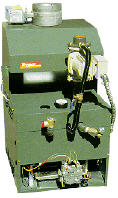

- Five model sizes – 42, 66, 90, 135 and 180 MBTUH
- Light Weight
- Factory Installed circulator pump and bypass
- Built in draft diverter
- Non-combustible floor base
- Compact Only 11″ or 18″ wide, depending on model
- No Thermal Shock
- Up to a 150° temperature difference
Go to the Raypak web site at www.raypak.com
![]()
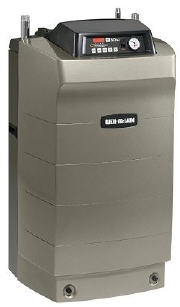
Over 92% AFUE and 98% for low temperature applications. The Ultra boiler features a new attractive design for installation in any setting. Features PhD Technology – an intelligent system that delivers Precision Hydronic heating and hot water needs while maximizing efficiency by measuring and responding to the Data parameters of your heating system. Cast mono block aluminum heat exchanger. Gas valve, blower and venturi technology that constantly maintains optimal air and fuel ratio at all firing rates.
Go to the Weil-McLain web site www.weil-mclain.com

For information on larger boilers, from small commercial to large industrial, see the Energy Solutions Center’s Boiler Burner Consortium web site at www.cleanboiler.org
Source: Text Bob Fegan 12/2008; images and logos from manufacturer’s web sites referenced and linked above;
© 2008 Energy Solutions Center400 N. Capitol Street NWWashington, DC 20001 All rights reserved. Legal Contact our webmaster
